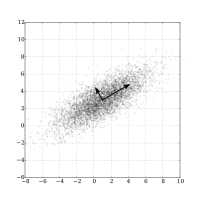
Photo from wikipedia
In hyperspectral images (HSI), most feature extraction and data classification methods rely on corrected dataset, in which the noisy and water absorption bands are removed. This can result in not… Click to show full abstract
In hyperspectral images (HSI), most feature extraction and data classification methods rely on corrected dataset, in which the noisy and water absorption bands are removed. This can result in not only extra working burden but also information loss from removed bands. To tackle these issues, in this article, we propose a novel spatial–spectral feature extraction framework, multiscale 2-D singular spectrum analysis (2-D-SSA) with principal component analysis (PCA) (2-D-MSSP), for noise-robust feature extraction and data classification of HSI. First, multiscale 2-D-SSA is applied to exploit the multiscale spatial features in each spectral band of HSI via extracting the varying trends within defined windows. Taking the extracted trend signals at each scale level as the input features, the PCA is employed to the spectral domain for dimensionality reduction and spatial–spectral feature extraction. The derived spatial–spectral features in each scale are separately classified and then fused at decision-level for efficacy. As our 2-D-MSSP method can extract features and simultaneously remove noise in both spatial and spectral domains, which ensures it to be noise-robust for classification of HSI, even the uncorrected dataset. Experiments on three publicly available datasets have fully validated the efficacy and robustness of the proposed approach, when benchmarked with 10 state-of-the-art classifiers, including six spatial–spectral methods and four deep learning classifiers. In addition, both quantitative and qualitative assessment has validated the efficacy of our approach in noise-robust classification of HSI even with limited training samples, especially in classifying uncorrected data without filtering noisy bands.
Journal Title: IEEE Journal of Selected Topics in Applied Earth Observations and Remote Sensing
Year Published: 2021
Link to full text (if available)
Share on Social Media: Sign Up to like & get
recommendations!